Rugby
Football
Basketball
Handball
Volleyball
Year and place of invention
1886
1863
1891
1912
1895
UK
UK
USA
GERMANY
USA
Year approved as an Olympic sport
2016 (rugby sevens)
1908 (under 21 years old, amateurs)
1936
(1936) and 1972
1964
Players in the world: amateurs and professionals (in millions)
264 (2006)
450 (FIBA)
61
260 (FIVB)
Licenced players (in millions)
3.5
38 (113,000 professionals-FIFA)
100
59 (400 professionals)
Last world champions (M/W) (2012 data)
New Zealand
Spain
USA
France
Brazil
New Zealand
Japan
USA
Russia
Russia
1.1.2.1 Basketball
Basketball is a team sport usually played indoors at competition level, even though it is also practised outdoors for recreational use (i.e. playgrounds in the city). Each team is composed of five players. The goal is to score points by passing the ball through the opponent’s basket, placed 3.05 m above the ground.
Each player has a specific role, and many combinations occur within a team. The typical scheme of a team is as follows:
The centre is usually the biggest and strongest athlete of the team. He is often standing close to the basket to be able to defend and has an important role in defensive and offensive rebounds.
If the power forward is usually smaller than the centre, he plays a similar role. He teams up with him in the basket zone and may also play further away from the basket.
The small forward is the most versatile player of the team; he is somewhat smaller than the others, agile and fast. Occasionally, he can come inside to help with rebounding.
The shooting guard is a player whose game is mainly oriented on the outside. He has various strategies of play for entering into the two-point area or scoring three-pointers.
The point guard is responsible for distributing the ball and organising the game in attack. In addition to a good ability to dribble, he must have an excellent vision of the game in order to distribute the ball to his teammates.
1.1.2.2 Football
Football, also called soccer in the USA, is a team sport played outdoors, with two opposing teams of 11 players. The objective is to place the ball into the opposing goal (7.32 m long and 2.44 m high) without using the forearms or hands (shoulders may be used). The goalkeeper is the only player allowed to catch the ball with his hands within his own penalty area.
Since he is the last person defending before the goal line, the goalkeeper occupies a critical position, which requires physical qualities (quick reflex skills), mental strength (authority) and expertise (he organises the defence). His hands are in direct contact with the ball, unlike the other players whose hands may only accidentally be in the ball’s trajectory.
1.1.2.3 Handball
Handball is a team sport, mostly played indoors, with two opposing teams of seven players (one goalie and six field players). The objective is to score more goals than the opponent in two 30-min periods.
Each player has a particular role and the number of substitutions is unlimited:
Goalkeepers are often relatively tall, in order to cover as much of the height of the goal as possible (2 m high). They also need significant flexibility to intercept the ball in the corners of the net, either with their hands or feet.
Left and right wingers: They are usually smaller than central players. The left-wing position is usually occupied by a right-handed, and similarly, right-wingers tend to be lefties. This position requires qualities of explosiveness and flexibility of movement.
Left and right backs: Similar to the wingers, the left backs are usually right-handed and vice versa. Their role is to initiate the attack; they are also able to jump to full extension to shoot and score goals.
Centre: This position is occupied by the playmaker of the team. He is at the centre of the field, launching attacks and leading them along with his teammates. Smaller in size, the centre should be able to infiltrate the opposing defence. His position requires speed and flexibility.
Circle runner: Positioned in the heart of the opposing defence, he blocks the defenders, either by staying in front of the goal and thus opening up for the wingers or by moving to the right or left, along the zone line.
1.1.2.4 Rugby Union
Rugby union, which is the most practised variant of rugby, has two opposing teams of 15 players.
It was introduced by British scholars and was only recognised as an official professional sport recently (1995). Rugby is played outdoors and both teams compete over an oval ball. Unlike any other ball sport, players can use both their hands and feet to pass and kick the ball.
The objective of the game is to ground the ball in the opponents’ touch-in goal area (called a try – Fig. 1.1) or to kick the ball in between the posts above the crossbar of the goal.
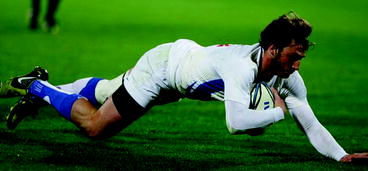

Fig. 1.1
A try is valid when the ball is grounded by the hands into the opposing touch-in goal zone. The hand needs to be in contact with the ball when it touches the ground. Maxime Medard, French national rugby union team
The positions are specific to each player: The different roles are rigorously defined, and its importance is emphasised on static phases such as the scrum (Fig. 1.2) or the touch (Fig. 1.3), which are two key techniques specific to this sport.
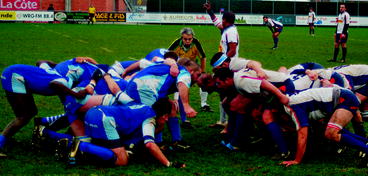
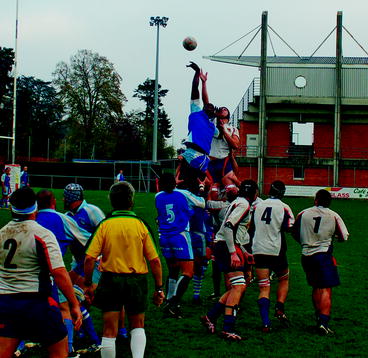

Fig. 1.2
The scrum

Fig. 1.3
The touch
The forwards are organised in three lines, beginning with the front row, composed of two props that surround the hooker. The second line consists of the locks, who are traditionally the tallest players of the team, while the back row is composed of three players. Altogether, the objective of the forward is to break the defence so as to open up free spaces for attacking.
The backs are also set up in three lines. The halfbacks, composed of the scrum half and the fly half, represent the first line. The second one, also called the three-quarters, is formed of two centres (inside centre, outside centre) and two wingers (left wing, right wing). Lastly, the fullback stays as the last man before the try line.
1.1.2.5 Volleyball
Volleyball is mostly practised indoors and involves two teams of six players separated by a net. The objective is to score points by grounding the ball in the other team’s court. There are many variants (beach volleyball, volleyball park, wallyball, ecuavolley, sitting volleyball), which are mainly distinguished by their environment or by the number of players. The dimensions of the volleyball court never vary. The net is placed at different heights depending on the age category of the players (2.43 m for men and 2.24 m for women).
The rules of volleyball have evolved largely between 1998 and 2000. Today, points can be scored by grounding the ball on the opposing team’s court or when the opponent fails to hit the ball back within the limits and commits a foul. Each team may touch the ball three times (in addition to eventual blocks) before throwing the ball back across the net, and consecutive contacts by the same player are not allowed (Fig. 1.4).
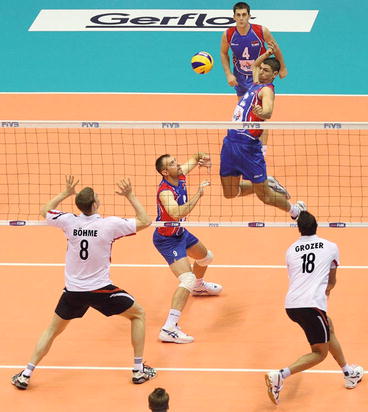

Fig. 1.4
Team of Serbia, World championship 2010, Trieste, Italy (Courtesy of Nikola Grbić, with permission)
The placement of the players is organised according to their number, from 1 to 6. Before the start of a point, they are all precisely positioned. However, once the ball is in play, they are free to move at their will. Players of the team receiving the serve rotate clockwise. Relatively recently, a particular position was introduced: The libero is a specialist for defence, who doesn’t attack, counter or serve.
1.1.3 The Relationship Between the Hand and the Ball
1.1.3.1 The Ball
The characteristics of balls (Fig. 1.5) vary depending on the sport (Table 1.2).
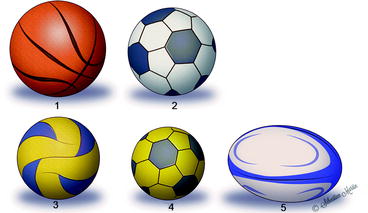

Fig. 1.5
1 basketball, 2 football, 3 volleyball, 4 handball, and 5 rugby, with their relative dimensions
Table 1.2
Characteristics of balls depending on the sport
Rugby | Football | Basketball | Handball | Volleyball | |
|---|---|---|---|---|---|
Circumference (cm) | 60/58–62a | 68–70 | 75–78 | 58–60 (M) | 65–67 |
54–56 (W) | |||||
Diameter (cm) | 28–30 | 22 | 23.8–24.8 | 21 | |
Weight (G) | 410–460 | 410–450 | 567–624 | 425–475 (M) | 260–280 |
325–375 (W) | |||||
Material | Leather or similar synthetic materials | Leather or other material | Leather | Leather | Composite materials |
Pressure (kg/cm2) | 0.67–0.70 | 0.6–1.1 | 0.294–0.318 | 0.4–0.6 | 0.30–0.325 |
Basketball
A basketball can be made of genuine leather, synthetic, composite, rubber, plastics or from the combination of all these materials. In professional competitions however, real leather is most often used. The grip can be optimised for superior grip and enables a stronger hold on the ball. Basketball can be played indoors or outdoors, which means that the conditions are an important element and can determine the type of ball to choose.
Football
All footballs are not necessarily made from leather. Other materials are used such as latex, polyurethane or PVC, which is often used for the outer layer. These materials provide resistance and better flexibility and also enable the ball to rebound. Nevertheless, the material of a football must also be selected depending on the field, which can be made of natural grass or synthetic. The conditions (humidity, dry ground, thick grass) may also influence the speed and trajectory of the ball.
The innovative materials used to make footballs are particularly smooth, especially when they are new. This influences the speed of the ball on certain types of lawn. It mostly depends upon which type of ball is used and what the conditions of the field are.
Handball
The handball is much smaller than a football or a volleyball. It is essentially made of leather, which is neither slippery nor shiny. There are other materials approved by the IHF (International Handball Federation) which can also be used. The ball must be resistant to the various impacts that occur with the ground but must also be sustainable over time. The leather gives players a strong hold on the ball while also enabling smooth contact and touch.
The ball consists of three parts:
1.
The outer layer is made of 32 panels and is mostly hand-stitched. It can either be in leather or in plastic. The leather provides excellent durability and resists well to abrasion.
2.
The layers of laminations can vary in numbers (2, 3 or 4). The rubber allows the ball to be extremely strong and durable. The cover, in PU, can resist abrasion and allows it to remain flexible, even in a cold environment. It is more enjoyable, lasts longer, resists to repeated strikes and gives a better feel/grip. The foam also provides flexibility.
3.
The bladder ensures vivacity, bounces and the respect of the trajectory. Butyl (synthetic) resists very well to pressure. The latex (natural) is porous and cheaper but deflates.
Rugby
Originally, the ball had a more rounded shape and was made of leather from pigs’ bladder. Rubber quickly replaced this former costly method. Its dimensions have changed over time; the ball gained length to facilitate the play by hand. Synthetic materials gradually replaced the slippery, smooth and porous leather. This change of surface helped to limit hand fouls (knock-ons, forward pass) and also allowed greater precision in the kicking game (better aerodynamics), which ultimately changed game strategies.
Currently, its size, weight and inflation pressure must meet strict criteria (Table 1.2). The outer envelope is usually made of rubber covered with a grip to facilitate adhesion to the hand. The ball is composed of layers of polycotton with added polymers to ensure a consistent form, bounces, and gain in distance. Its assembling is made with a very stiff and resistant polyester thread to avoid deformations of the ball. The recent presence of a second inflation valve (at the other end) seems best to balance the ball.
Volleyball
The volleyball is more flexible and lighter than the football. The white leather ball was a reference from the 1960s to the mid-1990s, but the cost of its production proved to be too expensive. Since the Summer Olympics of 1996, the leather has been replaced with composite materials that are much stronger, with the objective to give a softer and more pleasant feel for the players. Today, balls have a micro-foam under the surface to smoothen shocks with fingers. Synthetic balls also exist in PVC plastic, which is not as soft but much more resistant and mainly used in schools. The removal of the valve has played a role in the evolution of techniques in volleyball and enabled new skills such as the float serve. The different pieces are assembled altogether by a machine and calibrated by computers in research units to present a spherical shape that tends to perfection. Since 1998, the ball must be blue and yellow (official colour) for better visibility on television. Since January 1, 2004, the white leather balls are no longer approved by the FIVB.
1.1.3.2 Technical Moves, Seizing the Ball and Its Contact with the Hand
Basketball
Technical Moves
Attack: When a player is in possession of the ball, he often has to dribble to pass another player and go forward. Dribbling consists of bouncing the ball on the floor and moving along with it. Both hands are used alternatively, and they must always be above the ball; otherwise it is known as a carry, which is sanctioned by a foul. The attack in basketball also entails a fast passing game whereby a player may throw the ball to a teammate. To score points, a player needs to throw the ball into the basket. Both the throw and the shot are usually two-handed.
Defence: When a player shoots, the defenders are allowed to block or counter the ball as it is on the rise towards the basket. Nevertheless, if the counter is performed on a goaltending ball, it is penalised and the points are granted to the attacking team.
Grip on the Ball
The throw: Basketball players often try to control the throw with a backspin effect. In order to do so, the seam lines of the ball must be perpendicular to the long fingers of the dominant hand (Fig. 1.6). It is also important to leave a space between the ball and the palm, and fingers should be sufficiently spaced out from each other to catch the ball with one hand. The ball is precisely placed on the pulps of the fingers: The outer layer of the ball has a grip which facilitates its adhesion and therefore helps the accuracy of a technical move.
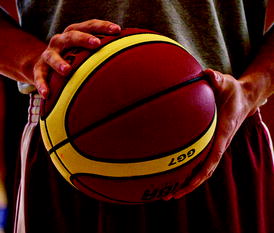
Fig. 1.6
Lines of seams should be perpendicular to the hand to control the ‘backspin’ effect
Balance hand: The nondominant hand is placed on the side of the ball. It should not apply any force or effect during the throw and must come off the ball first (Fig. 1.7).
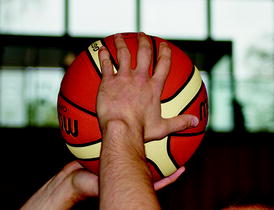
Fig. 1.7
The delivery: the nondominant hand comes off first. It shouldn’t apply any force or effect
Delivery: The elbow is placed underneath the ball and the wrist in extension (Fig. 1.8). The ball must stay in front of the player without going beyond the head. The elbow and the wrist then extend towards the basket in a straight line. The ball must come off the hand with a perfectly symmetrical backspin effect, while the guiding hand stays on the side of the ball and should not affect its trajectory (Fig. 1.9).
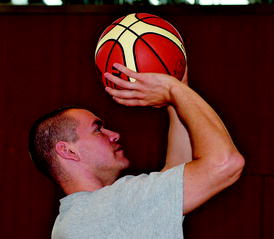
Fig. 1.8
It is mainly the second and third digits that are involved in the throw. The middle finger is the last one to come off the ball
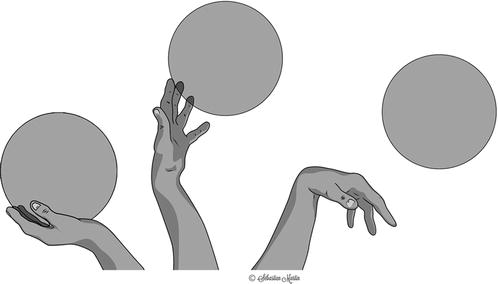
Fig. 1.9
Throwing a basketball: the second and third digits have a major role (G. Chick © 2012, all rights reserved)
Follow through: The wrists should be rather floppy and the fingers pointing towards the target, and its movement must accompany the ball (Fig. 1.9).
For dribbling, players control the ball by spacing out the fingers, grip it with the pulp and stabilise it with the little finger (Fig. 1.10).
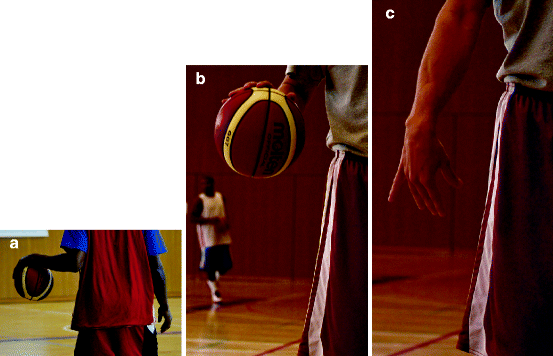
Fig. 1.10
Dribbling. The hand is over the ball (a). While the ball goes towards the ground, the fingers are spread out over the ball (b). After release, they are directed towards the ground (c). It is also worth to note the role of the little finger in grasping the ball
The ball can be grasped by one hand by spreading out the fingers and opening the first web. The plasticity of the pulps and the spiky covering on the ball are also important features to hold it well (Fig. 1.11).
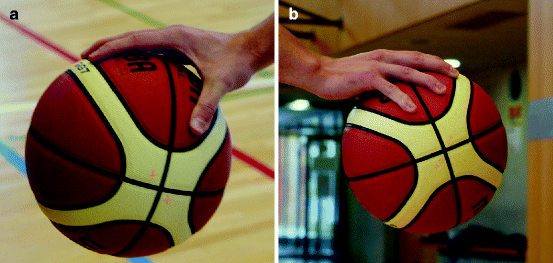

Fig. 1.11
Grasping the ball with one hand. Note the widening of the transverse arch of the hand. The palm is lifted off the ball (a). The role of the little finger for gripping the ball is crucial (b)
Handball
Technical Move
Attacking: Players alternate between dribbling with the ball and passing it to their teammates. They can take up to three steps ball in hand. If a player stops dribbling by seizing the ball with both hands, he is then forced to shoot or make a pass.
Multiple combinations within a team often precede the shot on goal. When a player is in a good position, he will either shoot from the ground or jump shoot over a defensive wall, which is a technique to generate more power. These techniques are one-handed.
The defence: While the attacking team shoots at the goal, the defenders are entitled to block the ball by making a wall and lifting their arms up.
Holding the Ball
Since the ball has a small diameter, it fits perfectly to the palm of the hand. The fingers are spread over the ball; the thumb stabilises it, while the little finger locks the position (Fig. 1.12).
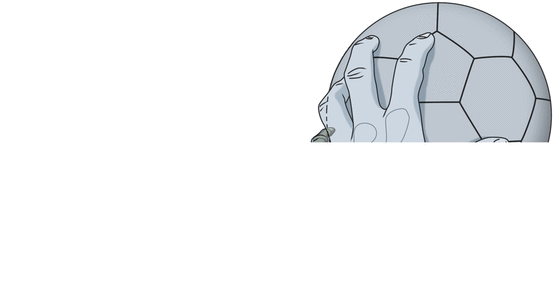

Fig. 1.12
Holding the handball (a) the thumb and little finger (b) have major roles (G. Chick © 2012, all rights reserved)
Pass and set shot: During the pass, the hand should be above the head, while the elbow is close to the head. The throw consists of a shoulder movement towards the target, with a flexion of the wrist at the end. The fingers should be pointing at the target. The movement is identical when a player shoots at the goal with his feet on the ground (for a right-handed, the left foot is in front and vice versa).
Jump shot: A jump shot is a special shooting technique in handball. The attacking player takes a couple of steps, jumps, fixes the goalkeeper and shoots. A right-handed player would jump from his left foot, while his right knee would be lifted up (Fig. 1.13). The characteristics of the throw are identical to the technique of the pass described above.
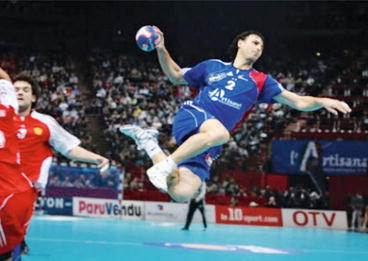
Fig. 1.13
Jump shot (Courtesy of Jerome Fernandez, captain of the French national handball team, with permission)
The roucoulette is a particular shooting technique. It consists of doing a quick wrist movement to give a strong spinning effect on the ball. The effect on the rebound will redirect the ball into the goal and thus surprise the goalkeeper. This shot is mainly used by wingers as an alternative if the goalkeeper closes the angles well.
Football (Goalkeeper)
Technical Moves
The goalkeeper is essentially equipped with gloves (Fig. 1.14), which are necessary to protect his hands against strong shots (clearance with the fists). They also enable a better grip on the ball than bare hands, often via a latex coating. Football gloves can also include pads to protect the fingers.
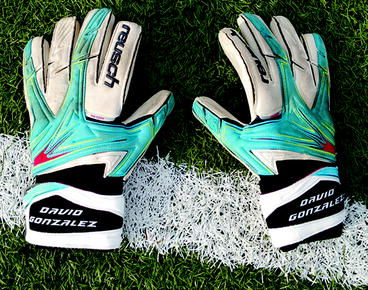

Fig. 1.14
Leather gloves without reinforcement (Courtesy of David Gonzalez Servette Geneva goalkeeper, with permission)
Several technical moves are carried out by the goalkeeper: blocking the ball after stopping a shot, seizing the ball in a safety position, throwing the ball at his teammates or deflecting a shot, which consists of a reflex save or punch of the ball in extension (Fig. 1.15).
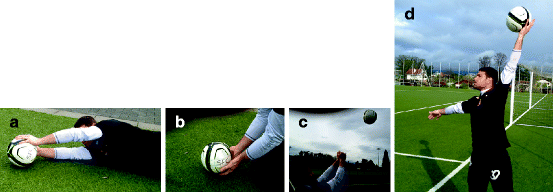

Fig. 1.15
Technical movements of the goalkeeper. (a) Ground dive. (b) Safe position for receiving the ball. The goalkeeper forms a safety net with his arms and part of his stomach. (c) Clearance with the fists. (d) Throw (Courtesy of David Gonzalez Servette Geneva goalkeeper, with permission)
The goalkeeper position in football requires the athlete to be relaxed and have strong reflexes. The hands move first towards the ball, and the body follows along with them.
Holding the Ball
In order to have a strong hold on the ball, goalkeepers place their hands in a W–shaped or triangle position over the ball (Fig. 1.16). This prevents the ball from slipping away and is relatively stable to block strong shots. The placement of the body on the ball’s trajectory also increases the chances to make the catch. According to a former goalkeeper from Russia, ‘If a ball is dropped, it is half a goal scored’ (Lev Yashin).
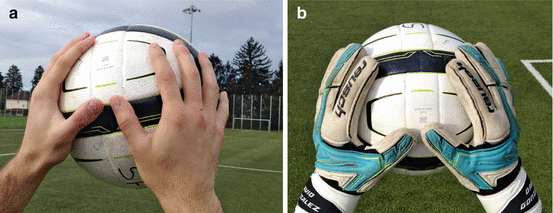

Fig. 1.16
Holding the ball with the fingers positioned in a W shape. Without gloves (a) and with gloves (b). The thumb has a major role
The diamond positioning: The thumbs and index fingers are placed so that the shape is similar to a rhombus (Fig. 1.17).
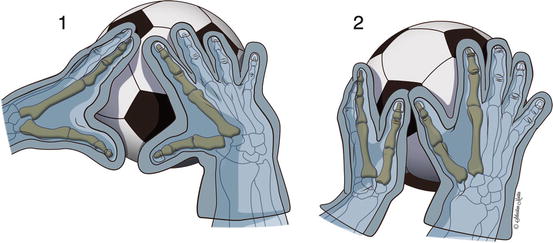

Fig. 1.17
1 Rhombus technique, 2 W-shaped technique (G. Chick © 2012, all rights reserved)
Unlike the diamond, the W-shaped technique involves separating indexes and letting only the thumbs in opposition to the ball. Nevertheless, this technique is relatively fragile and risky in rainy conditions.
The thumb and index have a prominent role in seizing the ball, and the heel of the hand helps for clearing it off.
Rugby
Skills
The ball has an elliptical shape and is played with in several ways: it can be thrown by the player’s hands, struck by the foot, or just held by a player.
The pass is one of the most important skills in Rugby. It needs to be very precise and fast. A failed pass will most probably end as a lost possession. The one carrying the ball can pass it backward to one of his teammates. The ball must not be thrown forward; otherwise it is sanctioned by a scrum or a penalty (Fig. 1.18).
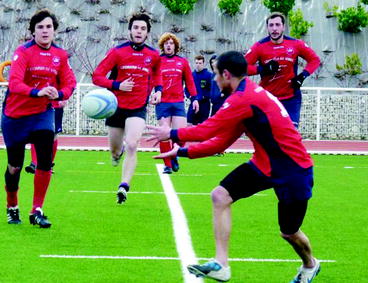

Fig. 1.18
The pass is necessarily thrown backwards (Courtesy of Charles Delibes, with permission)
The touch is another technical feature of rugby, which requires great accuracy and is the responsibility of the hooker.
When a player is running, he can block the ball under the armpit (Fig. 1.19).
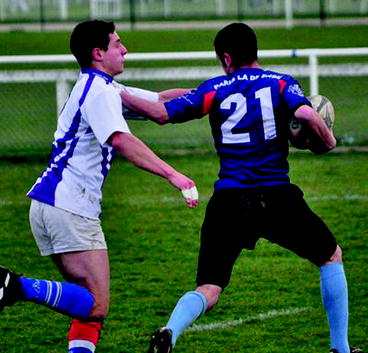

Fig. 1.19
The player protects the ball under the armpit to have a stronger hold on it and to keep it away from the opponent (Courtesy of Charles Delibes, with permission)
Holding the Ball
The most classic technique before making a pass is to hold the ball with both hands and have the elbows half flexed. The pass is carried out by a pendulum movement, which propels the ball to a teammate. The dominant hand help rotates the ball and thus has a major role in the direction given to the pass.
The technique has evolved and passes are increasingly made with an intense back to front movement. The top end of the ball is placed into the palm of one hand, which enables the player to give a rotary motion to the ball. The other hand is placed on the side further up; elbows are bent at 90° and then extend completely. This helps to increase strength and accuracy (Fig. 1.20).


Fig. 1.20
Classic pass: (a) positioning of the hands at the same level over the ball; (b) elbows are in half flexion and the ball is directed to the left of the player. The rotational movement of the ball is given by the right hand. The pass with a strong back to front movement: hands are placed differently over the ball (c), which enables to throw the ball with greater precision (d) (Courtesy of Thierry Barel, with permission)
Only one distinct player is responsible for the touch. He grasps the ball with both hands, the pulps of the fingers and the thumbs. The movement goes from back to front and over the head and propels the ball forward (Fig. 1.21).


Fig. 1.21
The touch. Throwing the ball
Volleyball
Technical Moves
There are numerous technical movements in volleyball. Since all players move around and multitask, they all have great volleyball skills. Prolonged contact with the ball is prohibited in volleyball (only team sport having this characteristic). The risk of injury is lower than in other ball sports, probably because there is no contact with the opposing team (players are separated by the net). Injuries occur most often during blocks, when the fingers are extended. Some players put on a strap to sustain an injury or to improve their strikes by increasing the stiffness of the fingers. The thumb (radial collateral ligament) and pinkie fingers are most vulnerable. The most inexperienced players are often injured on the fingers, even though the applied forces are smaller: The reasonz is a bad positioning of the fingers from the hand or a lack of synchronisation when blocking or during other defensive phases.
The serve: The player must stand behind the end line of the court and hit the ball with one hand so that it falls back inside the opponent’s court. Prior to the shot, the ball must be thrown or dropped. The player is allowed to throw the ball, jump and smash the ball (smashed serve). The player’s feet must remain outside the court when he hits the ball.
Stay updated, free articles. Join our Telegram channel

Full access? Get Clinical Tree








